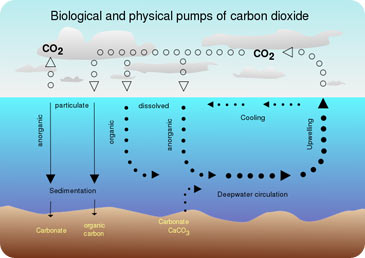The world’s oceans and seas are like big sponges. They soak up molecules from the atmosphere -- including carbon that’s produced by burning gasoline and other fossil fuels. In fact, the oceans absorb about a quarter of all the carbon that we humans release into the air.
 Air- ocean exchange of carbon dioxide. Credit: Hannes Grobe 21:52, 12 August 2006 (UTC), Alfred Wegener Institute for Polar and Marine Research, Bremerhaven, Germany
Air- ocean exchange of carbon dioxide. Credit: Hannes Grobe 21:52, 12 August 2006 (UTC), Alfred Wegener Institute for Polar and Marine Research, Bremerhaven, GermanyAccording to a report by the United Nations, human activity added about 11 billion tons of carbon to the atmosphere in 2008 alone, mostly in the form of carbon dioxide. The gas acts like a blanket, trapping the Sun’s heat and making Earth warmer.
But about a quarter of that amount was absorbed by the land, while another quarter -- about two and a half billion tons -- was absorbed by the oceans.
That happens in two ways.
In the first, microscopic plants at the surface use the carbon as part of the process of photosynthesis. They combine the carbon dioxide with water and sunlight to grow. They expel oxygen atoms, but hold onto the carbon. When they die, they sink to the bottom, but most of the soft part is recycled back to the water before they reach to the bottom.
In the other process, the organisms at the surface also form calcium carbonate for their shells by using chemical reactions between carbon and sea water. As they fall down to the ocean floor and accumulate, some of their remains form limestone over time, trapping carbon in the rocks.
The amount of carbon the oceans absorb varies from year to year. So scientists aren’t quite sure if the average amount is the same today as it was a few decades ago. Still, they are sure that the oceans continue to help clean up after us -- sponging up the carbon we puff out into the atmosphere.

